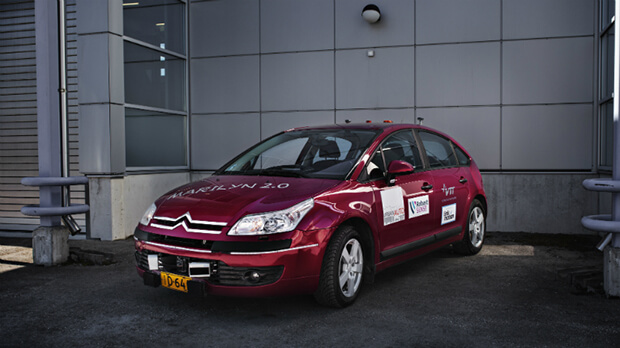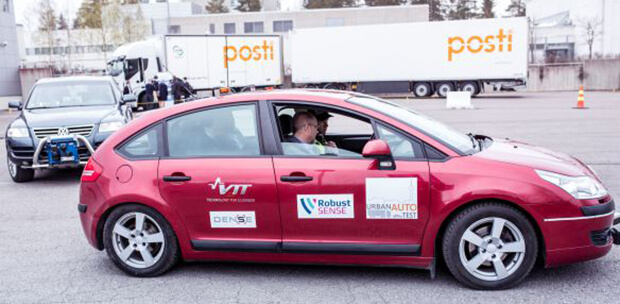Experimental ‘robot car’ that can see through fog

A research team at the VTT Technical Research Centre of Finland is claiming that they have had a breakthrough in obstacle detection for the future’s autonomous cars.
The researchers will demonstrate its latest development in autonomous car technology at ‘RobotSENSE’ in Ulm, Germany today, May 16.
The detection system is installed in a Citroen and they have playfully nicknamed it ‘Marilyn’. The Citroen car is equipped with a range of sensors including a new LiDAR system operating in a wavelength of 1550 nanometres, rather than the 905-nanometre wavelength of other LiDAR systems so more powerful.
The new more powerful LiDAR technology can pierce the curtain of droplets that constitute fog. This meteorological condition normally would hinder light and other radar detection systems would find it difficult to detect pedestrians and other vehicles. With the LiDAR system mounted on its roof, Marilyn can operate safely in snowy conditions, which is a critical factor for autonomous cars in Finland.
The LiDAR isn’t the only point of difference that separates Marilyn from the other six robotic vehicles that will be present at RobotSENSE; VTT claims that its software is more effective at filtering ‘point clouds’ out of the data. Matti Kutila, Project Manager of VTT’s RobotCar Crew team said:
“Although Marilyn’s vision is limited to roughly 30 metres in thick fog, the new LiDAR type allows the car to be driven slowly rather than having full stop,”

Conventional radar detection is also fitted to Marilyn include but there are limitations to conventional radar as it is hamstrung by its limited ability to detect non-metallic objects, but when used in combination with the new LiDAR system, the detection contributes to a clearer picture of the road ahead and any obstacles that may be in the path of the car. Kutila went on to say:
“Marilyn can also combine radar and LiDAR technologies by optimising the best aspects of the different sensors. This makes the automatic vehicle safer than a car driven by a person – although there are still lot of obstacles in development path, a major leap has been taken in the right direction,”
“We still have a long way to go on the journey towards 24/7 automated driving, but we are now a big leap closer to achieving our dream. If we think of this as a 42km marathon, we are now perhaps 10km closer to our goal.”

For the RobotSENSE demonstration, Marilyn will drive through a tent filled with a bank of fog and it is hoped that the car detection system will easily avoid a dummy placed strategically to demonstrate the inherent safety of the system. The fog created within the tent will be so dense, even human eyesight will not be able to detect the test dummy.
VTT’s choice of ‘Marilyn’ for the car’s nickname remains unexplained, but the Citroen is soon to be joined by another robotic car, which will be named ‘Martti’. According to the research team, Martti will be able to select a route based on LiDAR and ‘friction data’, presumably steering clear of black ice or other dangerous environmental conditions.

Author

Justin Kavanagh
Justin Kavanagh is a recognised leader
in automotive intelligence and vehicle
data supply to the entire motor industry.
He has almost 20 years experience in
building systems from the ground up.
As the Managing Director of Vehicle
Management System, he understands the
need and importance of trustworthy and
reliable vehicle history and advice to
both the trade and the public.
Follow me on LinkedIn